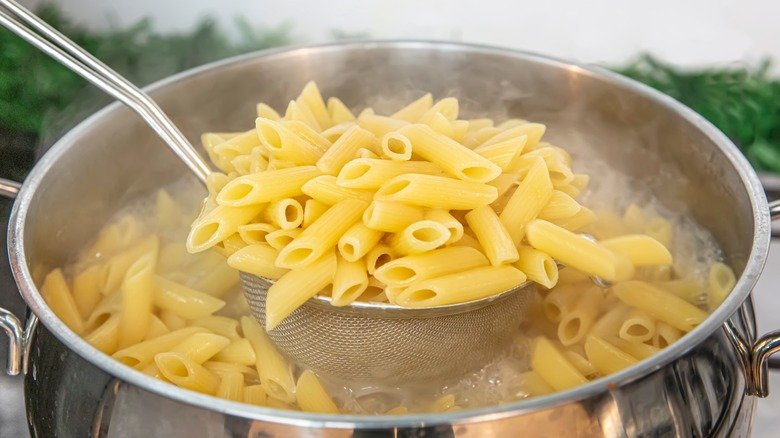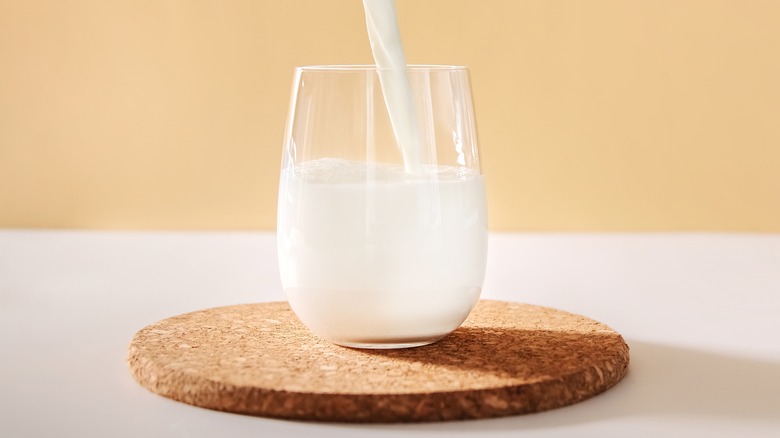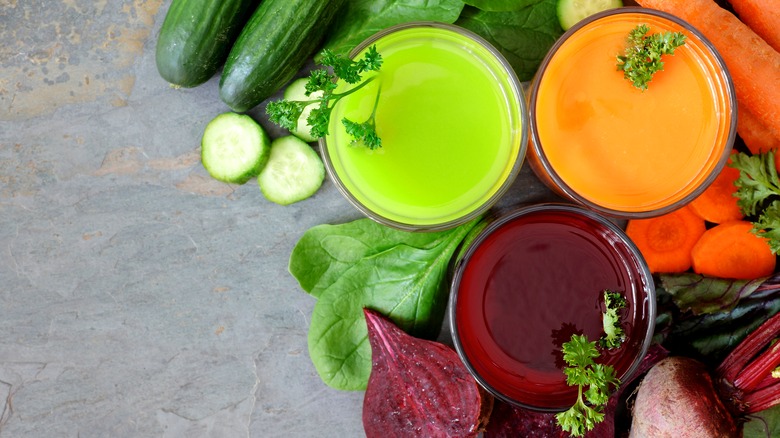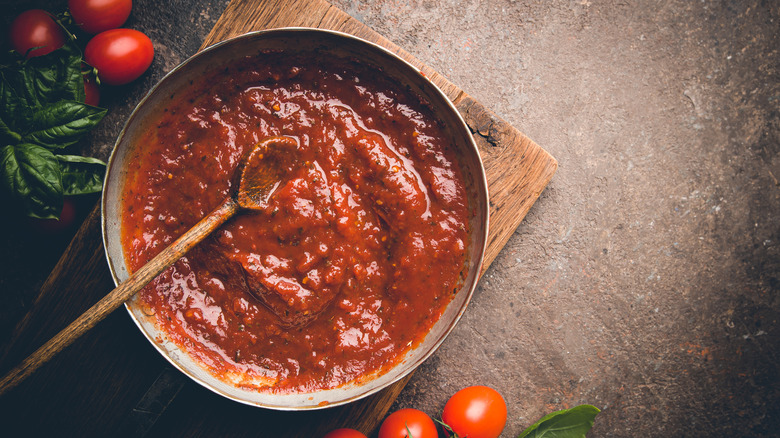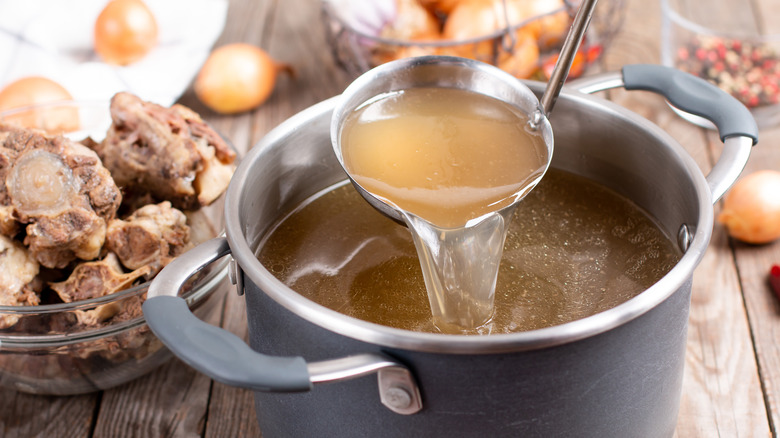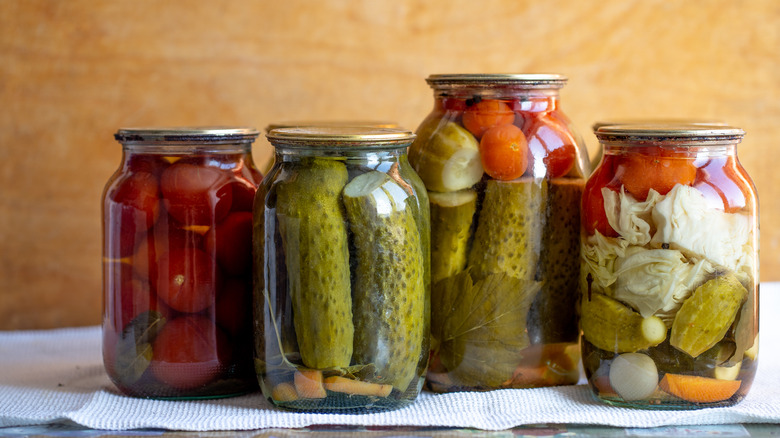7 Alternative Liquids To Cook Pasta In Other Than Water
We may receive a commission on purchases made from links.
Pasta is a beloved staple food, and we're all familiar with the (sometimes endless) wait for the water to boil so we can cook our pasta to perfection. But did you know that you can explore new and exciting flavors by cooking pasta in liquids other than water? Most home cooks know that it's a good idea to finish cooking pasta in the sauce, but you can take it a step further by changing the cooking liquid completely.
In this article, we'll dive into the world of unique pasta dishes made using liquids such as broth, wine, and even juice. From traditional favorites to new culinary creations, we'll show you how to elevate your pasta game with these unconventional cooking methods. So, whether you're a pasta enthusiast or a food lover looking to branch out, join us as we discover the endless possibilities of cooking pasta in liquids other than water.
Milk
Cooking pasta in milk is a unique and delicious way to add a rich, creamy flavor to your dish. It's not unheard of to boil macaroni in milk for homemade macaroni and cheese (via LiveStrong), but you can take that idea a step further to enrich even more pasta-based dishes. Boiling your chosen type of pasta in milk instead of water is the perfect solution for creamy pasta dishes, such as fettuccine alfredo.
There are a few key points to keep in mind if you go this route, however. Namely, you'll need to keep the temperature of the milk lower than water to prevent it from scorching, so you'll end up simmering your pasta rather than boiling it, according to Home Cook World. This can definitely work, but it'll take longer than cooking the pasta in water, and the texture might end up softer as a result. Frequent testing for doneness is important to prevent the final product from being soft and gummy.
Another thing to keep in mind is that milk will curdle if you add acidic ingredients to the dish, so this might not be the cooking method for you if you plan to add tomato sauce or citrus to your final dish.
Red wine
Cooking pasta in red wine is a unique and delicious way to add depth of flavor to your dish. The process is similar to cooking pasta in water, but instead of boiling the pasta in water, you simmer it in a mixture of red wine and water. The key to successfully cooking pasta in red wine is to use a wine that complements the flavors in your final dish and to be careful not to overcook the pasta.
According to Jim Mumford, a recipe writer speaking with Reader's Digest, not only does red wine impart plenty of flavor to the finished pasta, but the alcohol also helps cook the pasta faster. Plus, anyone who makes a lot of pasta knows you should save some of the pasta water to add to the sauce. When you cook pasta in red wine, this works even better, because you're imparting flavor along with the starchy liquid — never a bad thing!
Vegetable or fruit juice
Have you ever considered cooking pasta in fruit or vegetable juice? It may sound unusual, but it's a unique and delicious way to add a burst of flavor to your dishes, not to mention eye-catching color, according to Saveur.
The best way to do this for the best flavor and color is to parboil the pasta for a couple of minutes in salted water, bringing another pot of your chosen juice to boil at the same time (via Italy Magazine). After boiling for a brief time in the water, transfer the parboiled pasta to the boiling juice to finish it, then drain as normal before adding it to your dish.
Because this technique adds so much flavor to the pasta, you need to be sure the flavors complement whatever dish you're planning to make. While this could be a bit intimidating, it helps to look at it as a fun challenge! Say you want to put your own spin on a dish like sesame ginger pasta salad. A dish like this uses ginger in the dressing, and there are carrots in it as well. If you boiled the pasta in carrot juice or a mix of carrot juice and water, your dish would end up with a beautiful orange tone, and the carrot flavor would be integrated all the way through. That's just one example. Play around to see what other combinations you come up with.
Right in the sauce
Cooking pasta directly in the sauce is a time-saving and delicious way to add flavor to your dish. The process, also known as the "pasta in the pot" method, eliminates the need for a separate pot to boil the pasta and instead, the pasta is cooked directly in the sauce. This method is perfect for those who are short on time or for those who want to infuse their pasta with more flavor.
To cook pasta directly in the sauce, it's best to use a large pot or Dutch oven. Start by heating your sauce over medium-high heat. Once the sauce is hot, add the uncooked pasta and enough water (or stock or broth for even more flavor) to cover the pasta. Bring the mixture to a boil and reduce the heat to medium-low and let it simmer, stirring occasionally, until the pasta is cooked through. The pasta will absorb the sauce as it cooks, infusing it with more flavor.
This method is perfect for pasta dishes that have a thick sauce, such as lasagna, baked ziti, or spaghetti with meatballs. It's important to note that the cooking time varies depending on the type of pasta and the thickness of the sauce. So, it's best to check the pasta for doneness by tasting it or by using the package instructions as a guide.
Broth or stock
Cooking pasta in stock or broth can add an extra depth of flavor to your pasta dishes. According to Edible Phoenix, this method works best with thinner pasta, such as angel hair or spaghetti. They note that it works with thicker pasta as well, but you'll need more stock than might be worthwhile. This is also a fantastic method if you're cooking a soup you plan to add noodles to, since the noodles will add even more flavor to the soup itself.
When cooking pasta in stock or broth, it's important to keep in mind that the pasta will absorb the flavor of the broth, so it's best to pair it with a sauce that complements the flavors of the broth. For example, you can cook pasta in chicken broth and then pair it with a creamy chicken sauce, or you can cook pasta in vegetable broth and pair it with a tomato-based sauce.
This method is also a way to cut down on food waste by giving you a way to use up any leftover stock or broth you have in the fridge.
Herbal tea
It sounds weird, but hear us out on this. Instead of boiling pasta in water, cooking pasta in herbal tea infuses whatever food you cook or poach it in with a distinct, subtle flavor that will elevate your dishes and provide layers of flavor, according to MasterClass.
The process is relatively simple, but it does require some experimentation to find the right herbal tea and pasta combination. Start by brewing a good amount of your desired herbal tea, using high-quality and fresh herbs. Then, cook your pasta in a mixture of tea and water. The key is to use a ratio of two parts water to one part tea, to ensure the pasta cooks properly and doesn't become mushy.
Some popular herbal teas to use in this method are chamomile, rosemary, thyme, and basil. These teas have a delicate and subtle flavor that pairs well with pasta. Or, consider making a flavorful sauce for ramen with green tea (via The Tea Kitchen). You can also experiment with different types of pasta to find the right one that will absorb the flavors of the tea.
Pickle brine
If you haven't met a pasta salad you didn't like, and you're also a fan of pickles, this is the tip for you. Cooking pasta in pickle brine adds a tangy, salty flavor to your dish. Think of classic combinations: Many pasta salad recipes incorporate dill. Why not take it a step further and cook the pasta in a mix of dill pickle brine and water? If you love tuna casserole, this could also be the tip that takes your favorite recipe over the top, since dill and tuna were pretty much made for each other.
Cooking pasta in pickle brine requires a bit of extra attention. The salt in the brine can also help to soften the pasta, which can shorten the cooking time. According to a Reddit user who tried this method, a ratio of five parts water to one part brine resulted in a tangy finish. It is important to monitor the pasta closely and taste it for doneness, as cooking times will vary.
